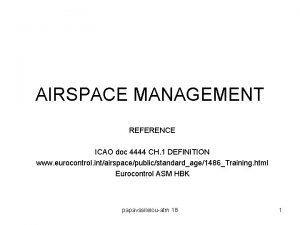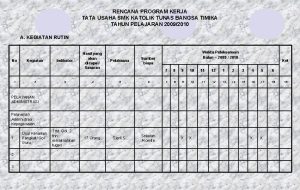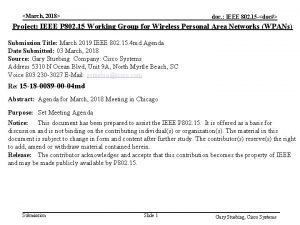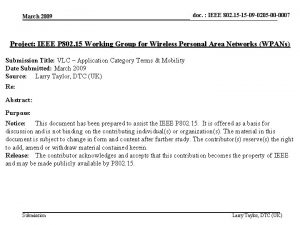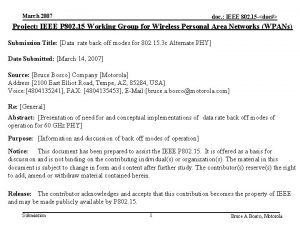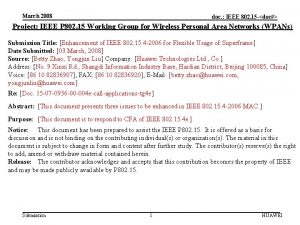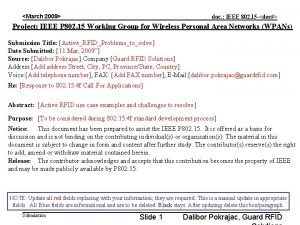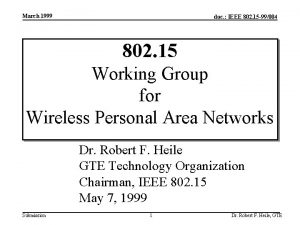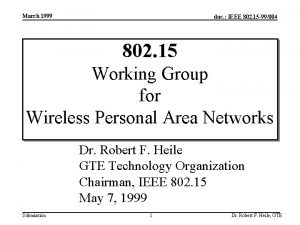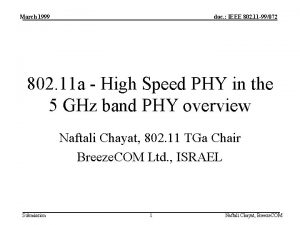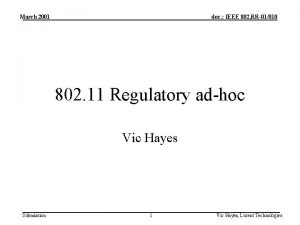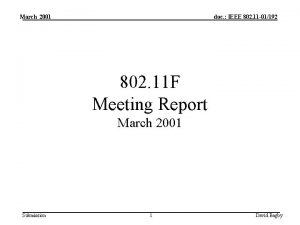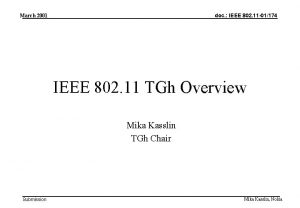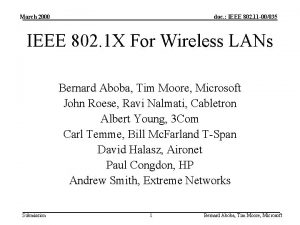March 2019 doc IEEE 802 11 190319 r















- Slides: 15

March 2019 doc. : IEEE 802. 11 -19/0319 r 1 Car-2 -Car - A survey on CAM statistics Authors: Submission Date: 2019 -03 -12 F. Berens, FBConsulting Sarl

March 2019 doc. : IEEE 802. 11 -19/0319 r 1 Abstract • The Car 2 Car Communication Consortium has performed a set of evaluation measurements to get an overview over the statistics of CAM messages in real implementations and deployments • CAM messages are non-deterministic in time and size • Period varies from 1 Hz to 10 Hz depending on the generation rules based on speed, heading and acceleration • Size varies from around 200 bytes to up to more than 700 Bytes depending on the environment and security content • A detailed report is available under: • https: //www. car-2 car. org/fileadmin/documents/General_Documents/C 2 CCC_TR_2052_Survey_on_CAM_statistics. pdf • A realistic performance simulation need to take these variations into account Submission F. Berens, FBConsulting Sarl

March 2019 doc. : IEEE 802. 11 -19/0319 r 1 Overview • Introduction • CAM structure overview & generation rules • Overall architecture & CAM generation agnostic to access layer technology • Traces collected • CAM sizes: variation versus time • CAM sizes: Distribution shape & statistics • CAM: time intervals (variation vs time) • CAM: time intervals (distributions) • Duty cycles (specific to IEEE 802. 11 p access layer) • Summary, key observations Submission F. Berens, FBConsulting Sarl

March 2019 doc. : IEEE 802. 11 -19/0319 r 1 Introduction • The study provides a comprehensive analysis of ITS-G 5 message traces collected in real test -drives in Europe in 2018. • Currently focusing on CAM • Following versions to include more messages types • Traces have been collected in standard traffic conditions and standard drives. • • Should be representative of most driving situations in Europe. Collected by car makers (VW, Renault), in different locations, with different ITS-G 5 hardware equipment from different vendors. Full study available under: https: //www. car-2 car. org/fileadmin/documents/General_Documents/C 2 CCC_TR_2052_Survey_on_CAM_sta tistics. pdf Submission F. Berens, FBConsulting Sarl

March 2019 doc. : IEEE 802. 11 -19/0319 r 1 What is a ‘CAM message’? • C-ITS works by sharing data between road participants • Cooperative Awareness Message one of the basic C-ITS message types: • Exchanged ad-hoc between cars multiple times per second • No infrastructure required • Comparable to USA ‘BSM’: Basic Safety Message • Containing information on position, direction, speed, etc • Crucial input for many safety related use cases • Electronic Emergency Brake Light • Intersection Collision warning • Cryptographically integrity protected (but not encrypted) • Frequency and size depends on situation • Focus of this study Submission F. Berens, FBConsulting Sarl

March 2019 doc. : IEEE 802. 11 -19/0319 r 1 CAM structure overview & generation rules CAM generation triggers: Position: A change in position by more than 4 m Heading: A change of direction of equal or more than +/- 4° Change of speed: A change of speed equal to or larger than 0, 5 m/sec Otherwise: Submission Generate a message after 1 second max F. Berens, FBConsulting Sarl

March 2019 doc. : IEEE 802. 11 -19/0319 r 1 Network & Transport Access technology RHS/CAA TS 102 539 -1 ICRW TS 102 539 -2 LCRW TS 102 539 -3 CAM EN 302 637 -2 DENM EN 302 637 -3 LDM TS 102 724 Geo. Networking EN 302 636 -4 -1/2 BTP EN 302 636 -5 -1 TS 103 097/102 94 x Security Facilities TS 102 723 -x Cross-Layer Ifx Applications TS 102 894 -2 Common Data Directory Overall architecture & CAM generation agnostic to access layer technology DCC - TS 103 141 Access Layer IEEE 802. 11 p and 11 bd Access Layer LTE-V 2 X … or … Submission F. Berens, FBConsulting Sarl

Traces collected March 2019 Trace name “VW urban” “VW suburban” “VW highway” “Renault urban” “Renault suburban” “Renault highway” Submission Companyproviding trace VW VW VW Renault Type of drive environment Urban Suburban Highway (slow) Urban Suburban Highway Location where trace was recorded Gifhorn, Germany Vienna, Austria VW urban VW suburban Renault suburban doc. : IEEE 802. 11 -19/0319 r 1 Standard Facilities layer profile ETSI ITS-G 5 ETSI ITS-G 5 C 2 C_CC profile 1. 3 SCOOP 1. 2, 2. 4. 1 VW highway Renault highway F. Berens, FBConsulting Sarl

March 2019 doc. : IEEE 802. 11 -19/0319 r 1 CAM sizes: variation versus time Example 1: Renault urban Example 2: VW highway (detail) Observation #1: CAM size keeps changing from one message to the next, for all the drives. Submission F. Berens, FBConsulting Sarl

March 2019 doc. : IEEE 802. 11 -19/0319 r 1 CAM sizes: Distribution shape & statistics Observation #2: The set of possible CAM sizes is very diverse, for all test drives. Observation #3: Significant differences in the upper part of the CAM distribution Observation #5: The average CAM sizes is typically around 350 Bytes Trace VW urban VW suburban VW highway Renault urban Renault suburban Renault highway Overall average Submission CAM sizes, mean value 339 Bytes 308 Bytes 297 Bytes 406 Bytes 399 Bytes 357 Bytes CAM sizes, min value 199 Bytes 182 Bytes CAM sizes, max value 526 Bytes 504 Bytes 500 Bytes 782 Bytes 765 Bytes 807 Bytes F. Berens, FBConsulting Sarl

CAM: March 2019 time intervals (variation vs time) doc. : IEEE 802. 11 -19/0319 r 1 Observation #8: In practice, the CAM time-interval very often changes from one message to the next, observed in all the drives. Note: quantisation of time interval is due to discrete GPS update frequency Submission F. Berens, FBConsulting Sarl

March 2019 doc. : IEEE 802. 11 -19/0319 r 1 CAM: time intervals (distributions) Observation #9: The distribution of the CAM time-interval is very diverse, and heavily depend on the drive scenario. Observation #10: The average values of the time-intervals vary between 0. 33 and 0. 47 seconds. Submission F. Berens, FBConsulting Sarl

March 2019 Duty cycles based on IEE 802. 11 access layer Trace VW urban VW suburban VW highway Renault urban Renault suburban Renault highway Total duration of all packets 1. 33 sec. 1. 94 sec. 1. 37 sec. 2. 18 sec. 1. 37 sec. 0. 84 sec. Duration of Long-term test drive duty cycle ~21 min. 0. 10% ~25 min. 0. 13% ~27 min. 0. 13% ~30 min. 0. 12% ~18 min. 0. 13% ~12 min. 0. 12% doc. : IEEE 802. 11 -19/0319 r 1 Max peak short-term duty cycle (1 sec. meas. ) 0. 26% 0. 29% 0. 27% 0. 40% 0. 41% 0. 39% Observation #12: The long-term duty cycles are consistently measured between 0. 10% and 0. 13%, for all test drives. This is compliant with the requirement of long-term duty cycle of max. 1%, by a comfortable margin. Example: VW suburban Submission Several hundreds of vehicles can be supported even without DCC (congestion control) F. Berens, FBConsulting Sarl

Summary, key observations March 2019 Observation ID Observation #1 Observation #2 Observation #3 Observation #4 Observation #5 Observation #6 Observation #7 Observation #8 Observation #9 Observation #10 Observation #11 Observation #12 Observation #13 Observation summary CAM size keeps changing from one message to the next, for all the drives. The set of possible CAM sizes is very diverse, for all test drives. Significant differences in the upper part of the CAM distribution, per manufacturer or facilities layer profiles Only between 25% and 35% of the messages do not contain certificates. The average CAM sizes is typically around 350 Bytes The approximate CAM size distributions can be observed: Distribution starts around 190 Bytes Typically, 30% of the messages are below 300 Bytes Typically, more than 50% of the messages are above 350 Bytes Typically, more than 30% of the messages are above 450 Bytes Speed and number of path. History entries are heavily correlated. In practice, the CAM time-interval very often changes from one message to the next, observed in all the drives. The distribution of the CAM time-interval is very diverse, and heavily depend on the drive scenario. The average values of the time-intervals vary between 0. 33 and 0. 47 seconds. In average, roughly only 50% of the time-interval deltas is zero The duty cycles are consistently measured between 0. 10% and 0. 13%, for all test drives. The short-term (1 -second) duty cycles peaks are measured between 0. 26% and 0. 41%. Note: blue observations are only explained in https: //www. car-2 -car. org/fileadmin/ documents/General_Documents/C 2 CCC_TR_2052_Survey_on_CAM_statistics. pdf Submission doc. : IEEE 802. 11 -19/0319 r 1 F. Berens, FBConsulting Sarl

March 2019 doc. : IEEE 802. 11 -19/0319 r 1 Conclusion • CAM generation based on ETSI EN 302 637– 2 is a highly dynamic and non -deterministic process • The dynamic generation rule guarantees an efficient resource usage since only actually required information are send out (spectrum efficiency) • Future message sets will have similar dynamic behaviour • 802. 11 bd access layer need to take these dynamic behaviour into account • Simulation assumptions for access layer should model this behaviour by: • Packet size should be variable and not fixed to 300 bytes • Packet delivery timing should be dynamic • Statistics can be derived from presented measurements Submission F. Berens, FBConsulting Sarl
 Bridges from 802.x to 802.y
Bridges from 802.x to 802.y Bridges from 802.x to 802.y
Bridges from 802.x to 802.y March march dabrowski
March march dabrowski Arquitetura ieee 802
Arquitetura ieee 802 Norma ieee 802
Norma ieee 802 Ieee 802 standard
Ieee 802 standard Bluetooth ieee 802
Bluetooth ieee 802 802 ieee
802 ieee Ieee 802
Ieee 802 Ieee 802 family
Ieee 802 family Ieee 802 3 compliance
Ieee 802 3 compliance Ieee 802
Ieee 802 Grihalakshmi magazine march 2019
Grihalakshmi magazine march 2019 Kaggle march madness
Kaggle march madness Icao 4444
Icao 4444 Program kerja tata usaha smk 2019 doc
Program kerja tata usaha smk 2019 doc














